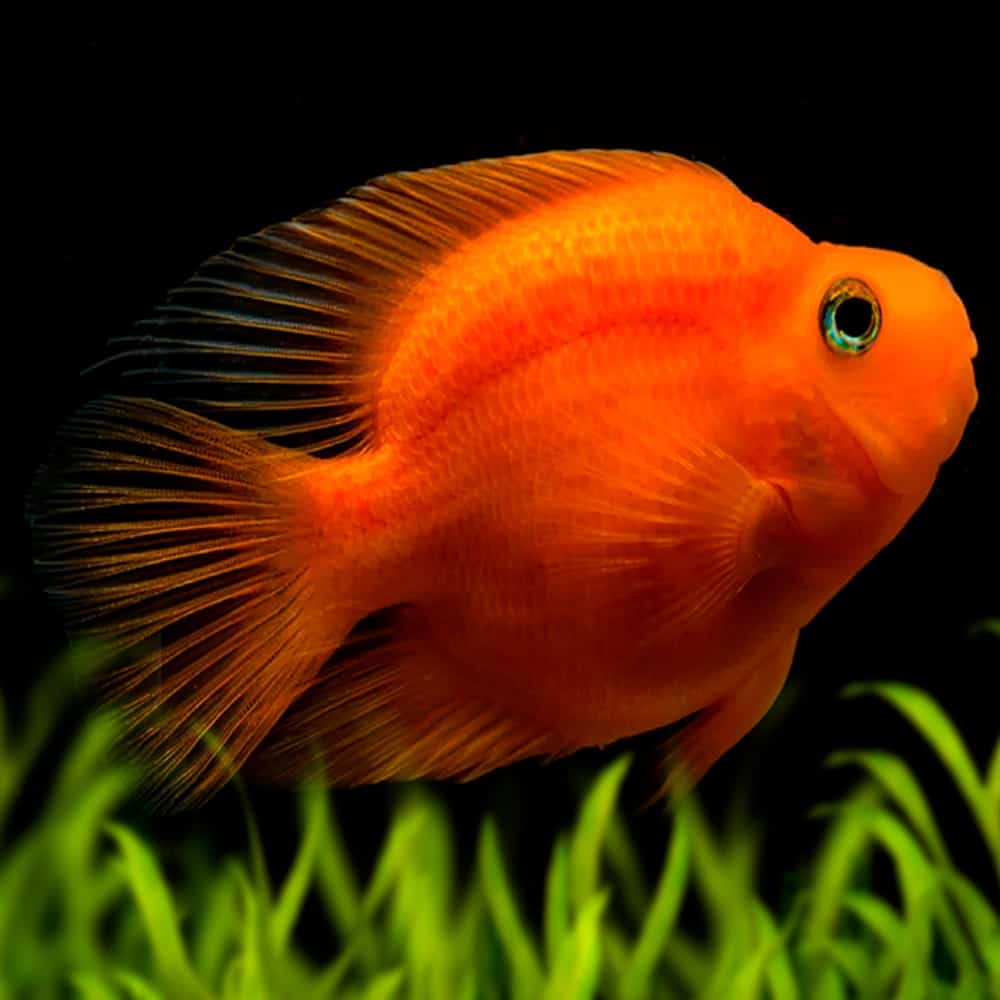| Care level | Intermediate |
| Temperament | Peaceful to semi-aggressive |
| Color | Bright orange |
| Lifespan | 10-15 years |
| Size | Up to 8 inches |
| Diet | Omnivore |
| Minimum tank size | 30 gallons |
| Temperature | 76°F to 80°F |
| Water conditions | Freshwater with open space |
| Tank mate compatability | Peaceful |
Average Size
The average Blood Parrot Cichlid size is around 8 inches in length for adult males and 6 to 7 inches in length for females. In addition to being shorter, females also have a more round/plump body.
In rare instances, Blood Parrot Cichlids can reach lengths of 10 inches. But these fish are few and far between.
Blood Parrot Cichlid Care
Generally, Blood Parrot Cichlid care is something that we recommend for aquarists with an intermediate level of experience. This is because they have some unique requirements you’ll need to follow if you want to keep them healthy and thriving.
Luckily, this hybrid fish species isn’t too demanding when it comes to the environment and water conditions (it’s easy to assume the opposite). With the right know-how, you can help your Blood Parrot Cichlids reach their full potential.
Tank Size
The minimum tank size for one Blood Parrot Cichlid is 30 gallons. These fish are rather active and need ample room to swim.
Of course, larger tanks are always welcome. Many aquarists like to keep a small group of these fish together. In that case, go for a tank that’s 60 gallons or bigger.
Water Parameters
Normally, you would model water parameters after a fish’s natural habitat. But because Blood Parrot Cichlids are hybrid fish created by breeders, they have no wild environment to model after!
As a result, the best approach is to look to the parent breed. More specifically, fishkeepers tend to model water parameters after the Midas Cichlid. This fish lives in warm rivers in Central America.
Blood Parrot Cichlids prefer similar water conditions. They like slightly acidic waters that are warm all year round. Use the following parameters to keep your aquarium comfortable for these fish to live in:
- Water temperature: 76°F to 80°F
- pH levels: 6.5 to 7.4
- Water hardness: 6 to 18 dGH
It’s important to test the water on a regular basis to be sure these conditions are stable. We recommend doing this a bit more often when you first purchase these fish (since they’ll still be adjusting to your tank).
What To Put In Their Tank
You can choose to go for a natural decor scheme or something a bit more artificial. These fish do fine either way!
That said, there are still some basics you need to cover.
When planning your aquarium, it’s important to strike a good balance between open swimming space and plenty of hiding places. As the fish gets more comfortable, they’ll spend more time swimming out in the open.
A fine sand substrate is recommended as well. Like other Cichlid species, these fish are known to dig. Hard gravel could cause cute and other physical injuries which can lead to more serious complications over time.
For lighting, keep things subdued. Many Blood Parrot Cichlid owners utilize red spectrum light. Soft standard lighting works well, too.
To keep the water conditions in good shape, invest in a high-volume filtration system, These fish produce a lot of waste, which could quickly sour the water and cause stress-related diseases.
Common Potential Diseases
Blood Parrot Cichlids are just as susceptible to disease as any other freshwater fish. The most common for this hybrid species are Ich and swim bladder disease.
Treating Ich isn’t too difficult. After moving the fish to a quarantine tank, you can use over-the-counter medications or treat the disease naturally with higher temperatures and light water salinity.
To avoid Ich, make sure that you’re testing water conditions regularly. Remember, Blood Parrot Cichlids produce a lot of waste. Change about 50 percent of the water every two weeks to keep levels stable and avoid stress.
Swim bladder disease is another common ailment. It tends to affect Blood Parrot Cichlids frequently. Some fish even have deformed swim bladders due to genetic defects.
The swim bladder controls buoyancy in the water, so diseased fish will have trouble swimming around the tank. Like Ich, this disease has a few different treatment options. However, there are cases in which the swim bladder is permanently changed, creating a lifelong challenge for the fish.
Food & Diet
Picking the right Blood Parrot Cichlid food isn’t challenging. These fish are omnivores that will readily accept most commercial foods.
For a high-protein snack, you can offer up some brine shrimp and bloodworms every once in a while (2-3 times a week max).
Thanks to their unique mouths, Blood Parrot Cichlids are messy eaters. Oftentimes, food will escape their mouths as they try to swallow it!
Limit feedings to only a couple of minutes, twice a day. After each feeding do your best to remove any excess food to ensure that the water quality doesn’t suffer.
Blood Parrot Cichlid Behavior & Temperament
Many in the fish trade refer to Blood Parrot Cichlids as a semi-aggressive species.
They can indeed act out and display aggressive behaviors. However, most of the time this only occurs when the fish is around other aggressive fish.
If you keep these fish in an overcrowded tank they’ll tend to be a bit more territorial too.
But as long as you avoid keeping them in the wrong environment, Blood Parrot Cichlids can be rather peaceful!
We would consider their behavior to be fairly calm and semi-active. They enjoy their privacy, so they’ll spend a lot of the day hiding out. When they’re not doing that, you can find them swimming around the middle of the water column. On occasion, they may venture down to the substrate to dig for food as well.





Reviews
There are no reviews yet.